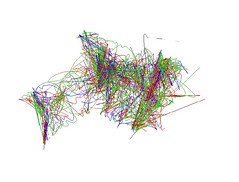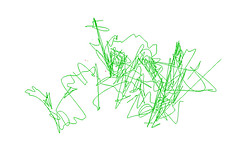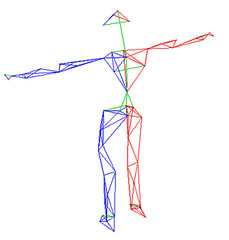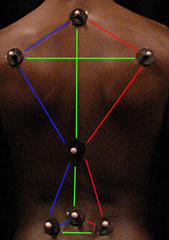splines in space
theorising through (dance) practice
some more notes on motion capture (mocap) [1], but first a few points;
- the traces are the 'raw' data from which i generate my transcriptions, i believe motion capture is the fastest way to get somatically accurate transcriptions.
- until i resolve the hand marker issue to an acceptable lvel of tracking (i.e. accurate and consistent) i'm usually tracking the palm, and sometime the thumb and index finger (metacarpless & phalanges).
- i use the traces in two distinct ways, a) as the initial stage of my transcriptions, and b) as choreographic scribbles.
ever since my early research into choreographic 'scribbles' i've had a renewed interest in drawing. clearly the concept of (dance) movement as a precursor to drawing is not new, nor is my usage particularly novel ... but i think it's important to our practice.
i tend not to use a full maker set when drawing my dances, i want a more refined noodle soup than everything in the cupboard. the particular combination and placement of makers will depend on my research (practice, task, development) goals. for example if was looking at diagonal - bilateral connectivity i might use a set of markers from the left foot to the right hand. i could then see the paths (shapes) that individual segments and connected whole took.
often i just want some interpretive documentation (so i can see at a glance how i'm using space / time) so i'll use a small set of offest markers (not located on skeletal landmarks) in distributed pattern. a set of eleven offset markers produce a scriible like this;

or you can just look at a single marker;

i can review these scribbles in two, three and four dimensions, with minimal practice you get deeper understanding of your movements cartography, allowing you to evaluate and refine these aspects almost immediately.
it's also possible to play around with the structures you see on the screen. normally what you look at is a set of links that approximate the human body. these links are derived from the markers and are customised by the user to suit their particular needs. often the markers are linked (virtually) to assist the template system the mocap software uses to identify the markers (by assessing the spatial relationship of the passive markers). this is how they look on the screen;

and here i have drawn the links onto a photo (of my back) to show how they relate to the physical markers / body;

when tracking the makers the software determines how much the links may 'stretch' before it breaks them. if we randomly lik the offset markers in differing patterns the software makes and breaks links dynamically, the effect is a kaleidoscope of geometric shapes. we can use the changing shapes as a tool to create more material, or to evaluate how often we repeat similar poses. i should also make it clear that the dancer (often me) does not look at the display screen whilst dancing
if you wanted to play with tools to turn motion into drawing there are a few applications you could adapt to your needs;
- optica [195kb zip windows XP] by panajotis mihalatos.
- flyt dig by ole kristensen (optica inspired)
i have other high and low tech methods of creating noodles (3d choreographic scribbles) but i save those for another time ...
[1] Motion capture is really motion tracking i'll talk about this more in forthcoming posts
prior posts
archives
newsfeed
blogroll
- ArtsJournal (dance)
- Break-A-Leg
- DA ... NCE
- Dancehunter
- david-o.net
- Downtown Dancer
- Great Dance Weblog
- Leigh Witchel
- motive (reason to move)
- Newness Dance
- Onward and Upward
- Rachel Howard.com
- Sort of a weblog
- thewinger
- uncoy.com | la vie viennoise
- We All Dance
- 3hive
- Archinect.com
- Cat and Girl
- Drawn! The Illustration Blog
- media art net
- networked performance
- PostSecret
- we make money not art
- usergland
0 responses to “ramen recital”
post a comment